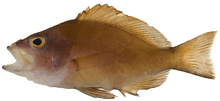Hypoplectrus nigricans
Hypoplectrus nigricans, the black hamlet, is a hamlet in the family Serranidae. It is native to shallow parts of the central Western Atlantic Ocean and Caribbean Sea. It grows to about 15 cm (6 in) in total length. It is a simultaneous hermaphrodite, with a breeding strategy known as egg trading. One fish acts as a female and lays a batch of eggs which the other fertilises. The following night, the roles are reversed.
| Hypoplectrus nigricans | |
|---|---|
 | |
| Scientific classification | |
| Kingdom: | |
| Phylum: | |
| Class: | |
| Order: | |
| Family: | |
| Genus: | |
| Species: | H. nigricans |
| Binomial name | |
| Hypoplectrus nigricans (Poey, 1852) [2] | |
| Synonyms[2] | |
| |
Description
Hypoplectrus nigricans is a small fish growing to a total length of 85 to 150 mm (3.3 to 5.9 in). The morphology and colouring of the fish varies across its range. Fish from Puerto Rico have greyish bodies, translucent pectoral fins, pointed pelvic fins and a caudal fin shaped like a crescent moon. Fish from Mexico and Belize are slightly smaller and have a darker body colour with dark pectoral fins, blunt pelvic fins and a short, square-cut caudal fin.[3]
Distribution and habitat
The species is native to the central West Atlantic Ocean. Its range extends from southeastern Florida and the Bahamas, through the Caribbean Sea and the Gulf of Mexico to Santa Marta in Colombia and to the islands off the coast of Venezuela. It is a reef fish, inhabiting reefs with both stony corals and soft corals.[1]
Ecology
As a simultaneous hermaphrodite, H. nigricans has an unusual reproductive strategy known as egg trading.[4] The fish is usually solitary, but at breeding time two fish come together at night. Courtship is initiated by one fish which temporarily takes a female role. The other fish acts as the male and fertilises a batch of eggs produced by the first fish. The following night their roles are reversed, and the second fish lays eggs and the first fish fertilises them. The two fish continue alternating roles in this way over the course of several nights. The pair usually stay together for the series of transfers, but sometimes each finds a different partner.[4]
Status
H. nigricans has a wide range and is a common fish. No particular threats have been identified and its population seems to be steady, so the International Union for Conservation of Nature has assessed its conservation status as being of "least concern".[1]
References
- Anderson, W.; Carpenter, K.E.; Gilmore, G.; Milagrosa Bustamante, G.; Robertson, R. (2015). "Hypoplectrus nigricans". IUCN Red List of Threatened Species. 2015: e.T16759111A16781793. doi:10.2305/IUCN.UK.2015-2.RLTS.T16759111A16781793.en.
- Bailly, Nicolas (2015). "Hypoplectrus nigricans (Poey, 1852)". WoRMS. World Register of Marine Species. Retrieved 13 January 2016.
- Aguilar-Perera, Alfonso (2004). "Variations in Morphology and Coloration in the Black Hamlet, Hypoplectrus nigricans (Teleostei: Serranidae)" (PDF). Caribbean Journal of Science. 40 (1): 150–154.
- Wootton, Robert J.; Smith, Carl (2014). Reproductive Biology of Teleost Fishes. John Wiley & Sons. ISBN 978-1-118-89139-1.
- Froese, Rainer and Pauly, Daniel, eds. (2008). "Hypoplectrus nigricans" in FishBase. December 2008 version.
External links
- Photos of Hypoplectrus nigricans on Sealife Collection
| Wikimedia Commons has media related to Hypoplectrus nigricans. |
